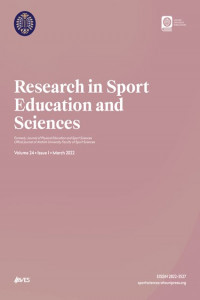Rekreasyon Deneyim Tercihi Ölçeği Geçerlik ve Güvenirlik Çalışması
Bu çalışmanın amacı insanların rekreatif etkinliklere katılım nedenlerini ölçmek amacıyla Manfredo ve arkadaşları tarafından geliştirililen Rekreasyon Deneyim Tercihi Ölçeği (RDTÖ) Türkçe versiyo-nunun geçerlilik ve güvenilirliğini incelemektir. Rekreasyon Deneyim Tercihi Ölçeğinin Türkçe ver-siyonunu oluşturmak üzere Manfredo ve arkadaşlarından izin alınmış ve ölçek uzmanlar tarafından Türkçe’ye çevrilmiştir. Araştırmanın çalışma grubunu İstanbul İli Beylikdüzü ilçesinde yer alan Yaşam Vadisi parkında boş zamanlarını değerlendiren 490 birey oluşturmaktadır. Rekreasyon Deneyim Tercihi Ölçeğinin faktör analizi için örneklem yeterliliğini belirlemek amacıyla Kaiser- Mayer-Olkin (KMO) ve Barlett testleri yapılmıştır. Barlett Küresellik Testi anlamlı (p < ,001) ve KMO testi sonucu ,78 çıkmıştır. Böylece ölçek maddelerinin faktör analizi için uygun olduğu tespit edilmiştir. Bu kapsamda ölçeğe ilişkin sorularla ilgili faktör analizi yapılmıştır. Faktör ana-lizi sonucunda öz değeri 1’den büyük yedi boyut ortaya çıkmış, bunlar doğa deneyimi, fiziksel fit-ness, fiziksel dinlenme, fiziksel stresten kaçış, yalnızlık, kalabalıktan kaçış ve aile ile beraber olma olduğu görülmektedir. Bu yedi faktörün varyansı açıklama yüzdesi 70,820 olarak hesaplanmıştır. RDTÖ’nin iç tutarlılık katsayısı ,828’dir. RDTÖ’nin DFA sonucunda ise x2/df değeri = 4,77 ve Yaklaşım Hatasının Kareli Ortalamasının Karekökü (RMSEA) = 0,088 olarak bulunmuştur. Sonuç olarak anal-izler, RDTÖ’nin park rekreasyonu tercihinde bulunan bireylerin rekreasyon deneyim tercihlerine yönelik yeterli düzeyde geçerlilik ve güvenilirlik değerlerine sahip olduğunu göstermiştir.
Anahtar Kelimeler:
Deneyim, tercih, rekreasyon, güvenirlik, ölçek, geçerlilik
Recreation Experience Preference Scale Validity and Reliability Study
The study aims to examine the validity and reliability of the Turkish version of the Recreation Experience Preference Scale developed by Manfredo et al. in order to measure the reasons people participate in recreational activities. Permission was obtained from Manfredo et al. to create the Turkish version of the Recreation Experience Preference Scale, and the scale was translated into Turkish by experts. The study group of the research consists of 490 individuals who spend their leisure time in Yaşam Vadisi Park, located in the Beylikdüzü district of Istanbul Province. Kaiser-Mayer-Olkin (KMO) and Barlett's tests were conducted to determine the sampling adequacy for the factor analysis of the Recreation Experience Preference Scale. Barlett Global Test was sig- nificant (p < .001), and the KMO test result was 0.78. Thus, it is deemed necessary to apply fac-tor analysis. In this context, factor analysis was made for the questions regarding the scale. As a result of factor analysis, seven dimensions with eigenvalues greater than 1 emerged, and these were confirmed as “physical,” “calmness,” “nature,” “loneliness,” “spending time with family.” The percentage of explanation for the variance of these seven factors was calculated as 70 820. The internal consistency k coefficient of Recreation Experience Preference Scale (REPS) is 825. As a result of the confirmatory factor analysis (CFA) of REPS, the value of x2/df was found to be 4.77, and root mean square error of approximation (RMSEA) = 0.088. As a result, the analysis showed that REPS has sufficient validity and reliability values for the recreation experience preferences of the individuals who prefer park recreation.
Keywords:
Experience, preference, recreation, reliability, scale, validity,
___
- Çokluk, Ö., Şekercioğlu, G., & Büyüköztürk, Ş. (2012). Sosyal bilimler i̇çin çok değişkenli i̇statistik: SPSS ve Lisrel Uygulamaları. Pegem Aka- demi Yayıncılık.
- Driver, B. L., & Brown, P. J. (1975). The opportunity spectrum concept and behavioral information in outdoor recreation resource supply inven- tories: A rationale. In Integrated inventories of renewable natural resources: Proceedings of the workshop. USDA Forest Service Gen. Tech. Rep. RM-55, Fort Collins, CO: Rocky Mountain Forest and Range Experiment Station.
- Driver, B. L., & Knopf, R. C. (1977). Personality, outdoor recreation and expected consequences. Environment and Behavior, 9(2), 169–193. [CrossRef]
- Driver, B. L., & Tocher, S. R. (1970). Toward a behavioral interpretation of recreational engagements, with implications for planning. Elements of Outdoor Recreation Planning, icinde Land and Leisure, 9–31.
- Graefe, A. R., Thapa, B., Confer, J. J., & Absher, J. D. (2000). Relationships between trip motivations and selected variables among Allegheny National Forest visitors. Forest Service Proceeding, 15(4), 107–112.
- Knopf, R. C., Driver, B. L., & Bassett, J. R. (1973). Motivations for fishing. In Transactions of the 28th north American wildlife and natural resources conference (pp. 191–204). Wildlife Communications Man- agement Institute.
- Manfredo, M. J., Driver, B. L., & Tarrant, M. A. (1996). Measuring leisure motivation: A meta-analysis of the recreation experience preference scales. Journal of Leisure Research, 28(3), 188–213. [CrossRef]
- Schumacker, R. E., & Lomax, R. G. (2004). A beginner’s guide to structural equation modelling (2nd ed). Lawrance Erlbaum Associates, Inc. s.81–82.
- Yaşlıoğlu, M. M. (2017). Sosyal bilimlerde faktör analizi ve geçerlilik: Keşfedici ve doğrulayıcı faktör analizlerinin kullanılması. İstanbul Üniversitesi İşletme Fakültesi Dergisi, 46(Özel Sayı), 74–85.
- Başlangıç: 2020
- Yayıncı: Atatürk Üniversitesi
